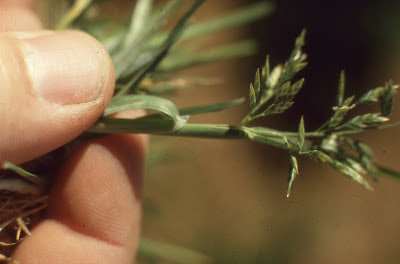believing it would still green up if I did that. I dont overseed it for a winter lawn. I just let it turn brown. Over
the last two weeks I’ve raised the height and fertilized. Looking much better, but probably need another week for
it all to get up to the same height. I’m getting small patches of darker green
wider leafs, presumably poa. Probably
little I can do to stop the poa.
one inch tall. However most bermudagrass would like to be at about 1/2 inch in
height. Lower than this is for the professionals in my opinion and requires
very frequent mowing to look good. The lower you mow, the more often you have to mow to look good. When you have a
thatch problem, mowing low will make it look worse. You really have to address
the thatch problem this fall.
If you don’t overseed, the best time to do it
would be in late summer (August) so that the grass has time to mend before
winter sets in. After dethatching, fertilize and water heavily to speed up the
repair process.
from dethatching in the fall than the spring. When you open up a lawn in the
spring there are lots of spring weeds that can invade. Yes, the small dark
green patches with seedheads on many of them now is Poa. Poa is tough to
control. The seed is everywhere and tracks with shoes. If your bermudagrass is
an improved type you can green it up more with nitrogen and iron and this way
the Poa is not as noticeable. But it will always grow a bit faster and is wider
bladed than the fine bladed improved bermudagrasses. Poa is a cool season grass
so if you don’t overseed the Bermuda you could spray it out in December or
January with Roundup when the Bermuda is dormant. The problem will be the Poa
seed that is everywhere in your lawn. It WILL come back.
 |
| This is a poa seedhead or inflorescence. Poa seeds heavily and can be seen as a discoloration or graininess to the poa. |
One benefit of overseeding is that it helps to eliminate some of the thatch
because you must dethatch the lawn sufficiently for the seed used in
overseeding can make good contact with the soil for germination. May years ago
common bermudagrass would be burned in the winter to get rid of the dead
surface grass and in the process any thatch accumulation. It is still
recommended that bermudagrass hayfields be burned for numerous reasons
including thatch removal and reduction of insects and diseases.
Years ago
bermudagrass lawns were also burned in the rural areas. We didn’t have a thatch
problem when bermudagrass was burned in the winter. Because we cannot burn dead
grass any more due to local ordinances, this dead grass remains and adds to the
thatch layer. We now substitute a gasoline-driven machine (called a dethatcher,
vertical mower or verticutter) instead of burning the dead grass. This of
course uses petroleum, adds pollutants to the air and leaves this bermudagrass
thatch that we have harvested for dumping somewhere. A tool I have used in the past is the Red
Dragon propane torch to burn debris. The model with higher BTU’s will burn
grass even if it is wet. This is an advantage because you can wet down the
bermudagrass dead lawn and still burn it which makes it more safe to use. There
are lots of advantages to burning bermudagrass thatch but local ordinances may
prevent you from using it. The burning is done just before spring growth.
